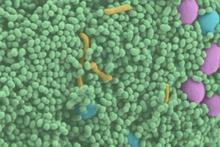Microbial Measurements

The NIST microbial metrology program focuses on critical national needs in microbiome community measurements, pathogen detection and identification, and microbial cell quantification. Each of these areas has seen disruptive technological innovations over the last decade, paving the way for new science. We are developing advanced measurement methods, documentary standards, and control and reference materials to improve confidence in microbial measurements and support the bioeconomy.
Current Activities and Products
Microbiome Community Measurements
Reliable, dynamic and discriminating measurements are needed to understand and fully exploit complex microbial systems for human health and industrial applications. Standards, such as reference data and materials, will help to assure the accuracy and comparability of measurements made in different locations.
- Measurements for Microbial Ecology
- Metagenomics
- Approaches to Control Biofilm Structure: Identification of experimental parameters that control biofilm physical structure to support structure-function studies.
- Metabolomics
Biosurveillance and Pathogen Detection
NIST scientists are partnering with academic, industry, and federal stakeholders to develop innovative standards for assessing analytical sensitivity, specificity, and relative performance of state-of-the-art pathogen detection technologies.
- Rapid Microbial Testing Methods (RMTM) Consortium – This stakeholder consortium was established to support the use of rapid methods to detect microbial contaminants in regenerative medicine and advanced therapy products.
- Standards for Infectious Disease Clinical Diagnostics
- Standards for Biothreat Detection – Development of reference materials, documentary standards, and guidance documents to support biosurveillance and the detection of biological threats.
- Standards for DARPA Friend or Foe Program – NIST is serving as an independent verification and validation (IV&V) laboratory
- Microbial Genomic DNA Reference Materials
- Individual vials of genomic DNA from four different bacterial strains – NIST RM 8375, varying in genome size and GC content to best challenge DNA sequencing technologies. (Available)
- Genomic DNA from 19 bacteria (+1 human DNA tube) – NIST Reference Material 8376 representing pathogens typical of common disease sites; including Gram positive and negative, low/high GC content, and near-neighbor organisms. (Available)
- Standards for Assessing the Safety of Recreational Waters from Fecal Contamination – NIST SRM 2917 with plasmid DNA containing 13 loci specific to identifying fecal contamination in water. (Available)
- Mpox (MPXV) Synthetic DNA PCR Standards -- RGTM 10223 with plasmid DNA containing 9 loci specific to identifying mpox using PCR. (Available)
Microbial Cell Quantification
Measurements of pure microbial cell suspensions, including total and viable cell number, are fundamental for quantifying microbes and necessary to assign reference values to whole cell reference materials.
- Microbial Enumeration Methods: Approaches to quantify the total number of cells and total amount of DNA in a planktonic microbial culture.
- Methods for Microbial Viability: Development of methods to quantify microbial viability using DNA-based approaches and fluorescence lifetime microscopy.
- Living Yeast Cell Reference Material: Engineered yeast cells prepared as a lyophilized cell material characterized for total cell count.
Engineering Biology
This work focuses on the development of measurements and tools that will enable improved predictability and scalability in the engineering of biological systems.

